- Home
- J. T. Edson
Rockabye County 4 Page 2
Rockabye County 4 Read online
Page 2
Two
Deputy Sheriff Bradford Counter stood in the darkness and waited, holding down the feeling of tension which threatened to rise and affect his speed of reaction. Any moment now a light would flicker on for an instant, while its control switch was worked back and forward. In that brief flash of illumination he must see his mark, draw his gun, shoot and make a hit.
On came the light, some seven yards away from where Brad stood and slightly to his left. Its momentary glow showed a life-sized man-shaped buff target with an X-ring in the centre of the chest area. The light also illuminated Brad: an exceptionally handsome young man with curly, golden blond hair, six foot three inches in height, one hundred and ninety-five pounds stripped and with the build of the muscle-men heroes of Italian epic movies. Brad wore a dark blue sharkskin shirt, open at the neck and sporting a yellow silk cravat, dark grey flannel slacks and black, crepe-soled Sears-Roebuck kangaroo leather boots. Around his waist hung an official pattern gun-belt, two and a half inches broad to support the weight it carried, with handcuff pouch and container for spare ammunition at the left side. The right side supported a high-riding, forward raked, steel-lined skimpy Bianchi Cooper-Combat holster incorporating the Elden Carl fly-off safety strap to hold Brad’s Colt Government Model .45 automatic in place during normal wear, yet still permitting a very rapid withdrawal of the weapon.
The gun was no snub-nosed hideout weapon, lacking in both power and accuracy; nor was it merely the fine mechanism which came off the Colt factory’s production lines. On purchasing the gun, Brad had sent it to the Pachmayr Gun Works in Los Angeles with instructions that it be accurized. This entailed tightening the fit between the cocking-slide and receiver, installing an enlarged bushing, decreasing barrel-slackness and improving the accuracy potential. The internal mechanism was worked over to give smoother functioning. To ensure quicker and more certain transfer of bullets from the magazine to the chamber, the feed ramp was polished to an icy slickness and the barrel’s mouth so trimmed that a round could pass over the joint effortlessly and without jamming. Externally the gun possessed combat stocks shaped to make certain Brad’s fingers always closed on it in the same manner. The butt’s grip safety had been welded into the ‘fire’ position and the manual safety catch enlarged for easier slipping into a condition of readiness. A trigger-shoe shoe spread the four pounds pressure necessary to fire the gun, giving the impression of a lighter pull to a squeezing finger without loss of safety margin. Finally the gun carried an adjustable rear sight to give increased accuracy.
To make the most of his gun’s advantages, Brad did not use the normal round-nosed service ammunition. For work he filled his magazines with heavy-duty hand-loaded, base-jacketed, truncated cone-shaped bullets of the type designed by the master of combat shooting, Jeff Cooper. Such bullets boosted the .45 automatic to 70.1 on the Hatcher Scale of Relative Stopping Power—which gauges various handgun calibers on their ability to produce an instant, one-shot hit on a human being—and put it third in line after the 76.3 of the .45 Single Action Army Colt and the thumb-busting 142.8 rating of the great .44 Magnum. Far above the 30.8 scored by the .38 Special snub-nosed revolvers many detectives were forced by their departments to carry for their protection.
While all the improvements did not put the big Colt in the same target class as an Olympic free-pistol, they turned it into the finest fighting handgun ever made. With that accurized Colt in his hands, using one or another of the braced-holds devised by combat masters, Brad could perform shooting of a kind usually only done by western movie heroes—except that Brad used live ammunition in his gun.
The light showed Brad his target briefly then was gone, throwing his weight on to his heels, Brad leaned his upper torso slightly backwards as his right hand flicked up towards the holster. Hooking his forefinger under the long tang of the fly-off strap, Brad released it from the retaining stud. Having been held in position against tension, the strap shot into the air on its release, the loop sliding from under the hammer and leaving all ready for use.
Fast though Brad reacted, he moved in pitch darkness as he speed-rocked the gun from leather. So perfect had the drill become that Brad neither slipped his forefinger into the trigger guard nor placed his thumb on the safety catch until the gun had cleared his holster and slanted towards where he had remembered seeing the target illuminated.
Barely had the light gone out when flame tore from Brad’s gun barrel and the crash of the shot merged with a dull clang. The sound told Brad his bullet had scored a hit, even before a voice boomed out of the blackness behind him.
‘Target One!’ it announced. ‘Hit!’
‘One down and five to go,’ Brad thought, applying the safety catch and holstering the Colt, although he let the fly-off strap lie where it had landed. ‘Can I do it?’
So far nobody had ever gone clean—made the maximum score—on all three stages of the ‘Night Shoot’, one of combat shooting’s hardest tests. Brad had fired the course many times, with a high score of twenty-eight out of thirty hits, twenty of which had been in the X-ring, and at different times managed to go clean on all three stages; yet he never could manage to make the elusive three straight under competition stresses and conditions.
On this occasion Brad had gone clean on the first stage; firing six shots from ten yards at an illuminated target, reloading and firing a further six in the dark—testing his ability to shoot accurately under an uncontrolled source of light, reload and re-engage the target with memory and body-orientation as the means of locating its position—the whole to be completed in fourteen seconds, the first four of which only were illuminated.
Nor had the second stage cost him any points. Starting at ten yards, in darkness and with his gun holstered, then engaging a line of three targets which he pinpointed by means of an electric torch held in his left hand. On both of the strings fired he hit each target twice in the four seconds allowed by the rules.
Now Brad faced the final stage. Seven yards away in the blackness stood a line of six targets, each to be individually illuminated at random and by a mere flick of a light switch. Once seen, Brad only needed to draw, shoot at and hit the designated target—in the dark.
Brad normally reckoned the last to be easiest of the three stages. Usually it would have been; but not when following his old shooting rival, Sam Allardyce, pride of the Presidio County sheriff’s office, after Sam had shot twenty-nine out of the thirty and put twenty-one of them in the X-ring. Sam had wiped Brad’s eye by a couple of points gathered running the Mexican Defense Course to win the Sheriffs’ Association of Texas’s Leatherslap Contest earlier that year and Brad hoped to snatch a victory on the Night Shoot to even the score.
Despite the thrill of competition, combat shooting was not a stunt, a silly childish game, nor an attempt to act like a television cowboy. There were times, even in the jet-age, when a lawman’s life depended on the speed of his draw and accuracy in placing home his bullets. Down on the Rio Grande where narcotics smugglers ran their hateful cargoes across the river from Mexico was but one occasion when a peace officer needed his gun—and not for a movie stunt. Being all too aware of that fact, Brad maintained his drawing speed and shooting eye at a high level. He was funny like that, he wanted to stay alive.
Three more times the light winked on, showing him the next target, each exposure being followed by the crash of his automatic an instant after darkness descended again on the scene. On each occasion the sound of the shot received punctuation in the form of lead clanging against target-steel.
Four down and two to go! Brad felt the tension rising inside him and fought to hold it in check. With a chance of the fabulous three-straight so close, he must not allow himself to tighten and goof the last couple of shots. Time seemed to be standing still as Brad waited for the next exposure.
It did not come. Instead the range officer’s voice boomed hollowly through the blackness.
‘Brad. You’re wanted on the telephone. I’m putting on the main lights—
now.’
A low grunt of annoyance burst from Brad. When a man built himself up to a peak in preparation for a great physical and mental effort—and combat shooting takes as much of both as any other strenuous sport needs—he did not take kindly to having his concentration ruined.
On giving the word ‘now’, after a brief pause to allow Brad to settle his alerted muscles so they would not react to the glow, the range officer switched on the main lights and illuminated the long building used for close-range target work. Ahead of Brad, six targets stood before the back-stop, four of them showed marks of his bullets.
Although seething with rage, Brad made no attempt to turn from the firing line until he had put his weapon in a safe condition. Setting the safety catch down into the ‘safe’ position, he holstered the Colt. Then he bent and picked up the fly-off strap, slipping the loop under the Colt’s drawn-back hammer and pressing home the retainer stud. With all safe he turned and walked back along the range. Some thirty men, members of the Rockabye County Combat Club and Sam Allardyce’s supporters—most of them law-enforcement officers of one kind or another—stood or sat on the rear of the firing line. Sam, big, burly, yet light on his feet, and the Presidio section all grinned.
‘Nice timing, Brad boy,’ Sam remarked. ‘Knew you couldn’t lick me and fixed to have a call put through to you.’
‘I bet it’s that blonde I saw you with last week at the Lido Club, Brad,’ a member of the Gusher City Police Department’s Narcotics Squad called.
‘She’ll be sorry if it is,’ Brad growled back.
Yet he doubted if the blonde would be calling him. While she might not be rated among the world’s great intellects, the girl knew a damned sight better than make telephone calls to him while he was engaged in combat shooting—or if she did not, she sure as hell soon would. Promising himself to ruin what could develop into a beautiful friendship if it should be the blonde, Brad passed through the crowd and entered the range officer’s sound-proofed cubicle by the main doors. He closed the cubicle door behind him, not wanting to give Presidio the wrong impression of Rockabye County’s gentlemanly behavior by allowing them to overhear his comments if it happened to be the blonde on the line.
‘Counter here,’ he growled into the receiver of the telephone, sounding as menacing as a winter-starved silvertip grizzly waking and finding a picnic party in its den-cave.
‘Brad!’ replied a male voice so strained with tension and emotion that he barely recognized it. ‘This’s Sam Cuchilo—I’ve bad news ’
Ten seconds later Brad had forgotten the blonde, his thoughts on the subject of folks ruining his concentration and his desire to make the three-straight. The words crackling over the telephone wires to his ears shook him brutally and he could understand why Deputy Sheriff Sam Cuchilo, that usually unemotional full-blood Comanche Indian college-graduate, sounding so strange and slightly incoherent.
‘My God!’ Brad gasped. ‘When, and where?’
‘Not five minutes ago. I’m on watch at the office and the call was relayed over the hot-shot speaker. It was down at the depot on Station Street, out front of the main entrance.’
‘I’ll go straight over. Thanks, Sam.’
He hung up without further speech. Having heard all he needed to, Brad did not want to waste any more of Sam Cuchilo’s, or his own, time.
Replacing the receiver, Brad leaned for a moment on the desk, allowing his churned-up feelings to have their violent race before trying to regain control. With the spasm passed, he took out the big automatic, removed its magazine and then worked the slide to kick out the cartridge from the chamber. Taking a reserve magazine from his belt pouch, he ran a thumb over the top bullet. Unlike the ejected round, the bullet carried a head shaped like a truncated cone. Thrusting home the magazine with its heavy-duty bullets into the butt housing, Brad drew back and released the slide to feed the top round into the chamber. After setting the safety, he holstered and secured the gun. Sucking in a deep breath, Brad pocketed the discarded magazine and round. Then he walked out of the room.
It said much for Brad’s self-control that his face showed nothing of the shock brought by the message. Every eye turned towards him and the men, most of them schooled in the art of reading facial expressions, read nothing from his features.
‘Are you shooting again tonight, Brad?’ asked the range officer.
‘Not tonight,’ Brad answered, fighting to hold his voice steady. ‘I have to leave right now.’
‘She can’t be that impatient, Brad,’ put in the man who suggested the blonde as a possible interruption to the business of the evening.
‘Chasing women, for shame,’ grinned Allardyce. ‘You ought to keep your eye in, Brad. A lawman never knows when he’s likely to need a gun.’
‘I may need to know real soon,’ Brad answered. ‘Tom Cord’s just been shot and killed.’
The words brought a sudden descent of shocked silence. Most of the men present had known and liked Deputy Sheriff Tom Cord and all were aware that Tom had been Brad’s partner. While the men knew Brad to be something of a practical joker, he always took combat shooting in the correct manner, as a deadly serious subject; and no lawman ever joked about his partner being killed.
After watching Brad leave the range, two of the men exchanged glances. They were detectives on the G.C.P.D. and, although both had a wife and family awaiting their return, knew they would report to their respective station houses in case they might be needed. Silently they left the room and the other local officers prepared to make their departure.
‘That’s all for tonight, boys,’ the range officer announced quietly. ‘Let’s clean up and close shop.’
‘You local badges’d best get going,’ Allardyce put in. ‘We’ll stop on and tend to things here.’
On leaving the building, Brad walked across the parking lot to where his imported M.G. MGB convertible stood waiting. Despite the M.G., the fact that he lived in an apartment on snob Upton Heights, dressed fashionably and expensively, and spent at least fifteen dollars a week on training ammunition, Brad was not a corrupt, bribe-taking officer. Born into one of Texas’ richest families, he might have been employed by the Counter Oil Company, run their big ranch or joined one or another of the various subsidiary interests of his kin; but some desire, instinct, call it what you will, drove him to become a deputy sheriff. Possibly it stemmed back to the blood of his great-grandfather. Mark Counter had been one of the old-time gun wizards and, if all the legends be true, quite a man in his day. i
Whatever his reasons, Brad gave up a sinecure in the family business empire. First he majored in Police Science and Administration at the University of Southern Texas and then, with some assistance from his maternal grandfather, took the F.B.I.’s twelve week police officers’ training course. With that behind him, Brad applied for a post as deputy under Jack Tragg, the sheriff of Rockabye County. Brad had been a deputy for over a year. In the early days he tried maybe a mite too hard, feeling he must prove to the other officers that he gained his post on merit and not through the good offices of the Counter millions. Brad took more than his fair share of the dull office routine, the boring stints as court bailiff, serving out writs, and sitting through lonely, miserable stakeouts in areas where the waiting was done under a tree or crouched in a clump of mesquite instead of in the relative comfort of a car or undercover truck.
Three months back Brad had helped Jack Tragg to run down a vicious gang engaged in bringing illegal immigrants across the border, and while cracking the case had also trapped a mighty smart smuggler. After that Brad had no longer needed to prove himself to anybody—not even to Bradford Counter.
Brad did not discount what he owed to Tom Cord for his success. Tom had always been helpful, ready with advice and eager to pass on the wisdom gained in many years of law enforcement. Despite the difference in their ages, they had been close friends. Now Tom lay dead, shot down like a dog. Brad swore he would get the killer.
Cold, controlled anger throb
bed through Brad as he drove the M.G. out of the parking lot and swung west along the track bordering the large, well-equipped ranges of the Rockabye County Shooting Club. A mile ahead glowed the lights of Gusher City and somewhere in the sprawling county seat was the man who had killed Tom Cord.
Keeping the M.G. at a steady forty, Brad reached the edge of town. A black and white radio patrol car of the G.C.P.D. cut out of a side valley and after him. Knowing better than to try to out-run the R.P., even though the matter be urgent, he brought the M.G. to a halt. The R.P. drew alongside and stopped, its shotgun—the local term for the crewmember not at the steering wheel—started to climb out.
‘All right, lead boot,’ he began, ‘where at’s th—’
Taking out his identification wallet, Brad held it so the shotgun could see the enclosed deputy’s badge and official ID card.
‘Counter, Deputy Sheriff,’ he said. ‘I want “code three” cover to the depot on Station Street.’
Instantly the patrolman’s slightly aggressive attitude changed. While he objected to Upton Heights’ bloods careering through town in their fancy imported sports cars—probably because he could not afford one and disliked seeing folks enjoying leisure hours while he worked—the shotgun had been listening to his radio and knew the reason for the big blond deputy’s haste in reaching Station Street. A deputy sheriff in Rockabye County held equivalent rank to lieutenant of the Patrol Bureau; but even without the disciplinary pull the patrolman would have been only too pleased to help out under the circumstances.
‘Start that heap, sir,’ he ordered, jerking his head back into the R.P. ‘Get rolling, Stan.’
A few seconds later Brad’s M.G. raced through the quiet streets, the Sunday night’s traditional calm split by the wailing of the R.P.’s siren as its flashing red light gave out a ‘code three’ warning to all traffic that they must give way to the two vehicles speeding across town on urgent business.

 Calamity Jane 11
Calamity Jane 11 The Floating Outift 33
The Floating Outift 33 Cap Fog 5
Cap Fog 5 The Floating Outfit 34
The Floating Outfit 34 The Code of Dusty Fog
The Code of Dusty Fog The Floating Outfit 21
The Floating Outfit 21 The Floating Outift 36
The Floating Outift 36 Calamity Jane 2
Calamity Jane 2 Calamity Jane 6: The Hide and Horn Saloon (A Calamity Jane Western)
Calamity Jane 6: The Hide and Horn Saloon (A Calamity Jane Western) Waco 7
Waco 7 The Floating Outfit 25
The Floating Outfit 25 Waco 7: Hound Dog Man (A Waco Western)
Waco 7: Hound Dog Man (A Waco Western) The Floating Outfit 47
The Floating Outfit 47 The Floating Outfit 42: Buffalo Are Coming!
The Floating Outfit 42: Buffalo Are Coming!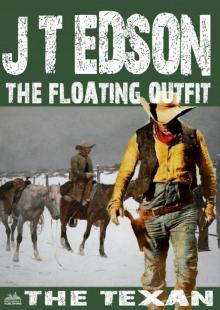 The Floating Outfit 46
The Floating Outfit 46 Dusty Fog's Civil War 11
Dusty Fog's Civil War 11 The Floating Outfit 61
The Floating Outfit 61 The Owlhoot
The Owlhoot Alvin Fog, Texas Ranger
Alvin Fog, Texas Ranger The Floating Outfit 34: To Arms! To Arms! In Dixie! (A Floating Outfit Western)
The Floating Outfit 34: To Arms! To Arms! In Dixie! (A Floating Outfit Western) The Floating Outfit 44
The Floating Outfit 44 Dusty Fog's Civil War 10
Dusty Fog's Civil War 10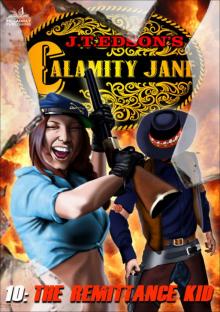 Calamity Jane 10
Calamity Jane 10 Cap Fog 4
Cap Fog 4 The Floating Outfit 51
The Floating Outfit 51 The Floating Outfit 50
The Floating Outfit 50 The Floating Outfit 49
The Floating Outfit 49 The Floating Outfit 10
The Floating Outfit 10 Apache Rampage
Apache Rampage The Floating Outfit 15
The Floating Outfit 15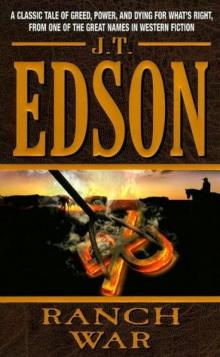 Ranch War
Ranch War The Floating Outfit 11
The Floating Outfit 11 The Devil Gun
The Devil Gun Sacrifice for the Quagga God (A Bunduki Jungle Adventure Book 3)
Sacrifice for the Quagga God (A Bunduki Jungle Adventure Book 3) Comanche (A J.T. Edson Western Book 1)
Comanche (A J.T. Edson Western Book 1) The Floating Outfit 48
The Floating Outfit 48 Wacos Debt
Wacos Debt The Rebel Spy
The Rebel Spy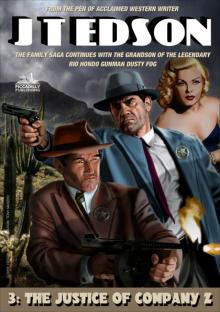 Cap Fog 3
Cap Fog 3 Trouble Trail
Trouble Trail Cold Deck, Hot Lead
Cold Deck, Hot Lead Rockabye County 4
Rockabye County 4 The Bullwhip Breed
The Bullwhip Breed Set Texas Back On Her Feet (A Floating Outfit Western Book 6)
Set Texas Back On Her Feet (A Floating Outfit Western Book 6)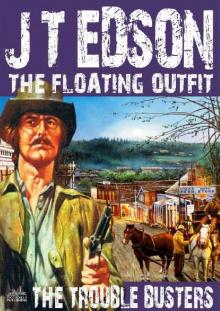 The Floating Outfit 25: The Trouble Busters (A Floating Outfit Western)
The Floating Outfit 25: The Trouble Busters (A Floating Outfit Western) Fearless Master of the Jungle (A Bunduki Jungle Adventure
Fearless Master of the Jungle (A Bunduki Jungle Adventure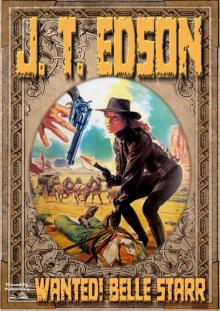 Wanted! Belle Starr!
Wanted! Belle Starr! The Big Hunt
The Big Hunt Running Irons
Running Irons The Floating Outfit 19
The Floating Outfit 19 You're in Command Now, Mr Fog
You're in Command Now, Mr Fog The Floating Outfit 27
The Floating Outfit 27 Texas Killers
Texas Killers Ole Devil and the Mule Train (An Ole Devil Western Book 3)
Ole Devil and the Mule Train (An Ole Devil Western Book 3) Bunduki and Dawn (A Bunduki Jungle Adventure Book 2)
Bunduki and Dawn (A Bunduki Jungle Adventure Book 2) The Fortune Hunters
The Fortune Hunters The Floating Outfit 12
The Floating Outfit 12 The Hide and Tallow Men (A Floating Outfit Western. Book 7)
The Hide and Tallow Men (A Floating Outfit Western. Book 7) Young Ole Devil
Young Ole Devil Slip Gun
Slip Gun The Drifter
The Drifter The Floating Outfit 45
The Floating Outfit 45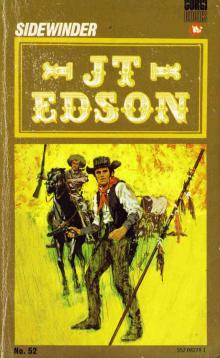 Sidewinder
Sidewinder The Ysabel Kid
The Ysabel Kid Waco 6
Waco 6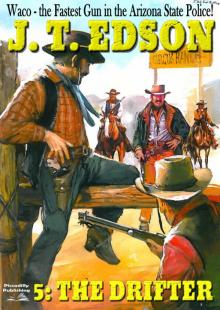 Waco 5
Waco 5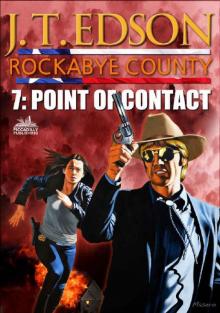 Point of Contact
Point of Contact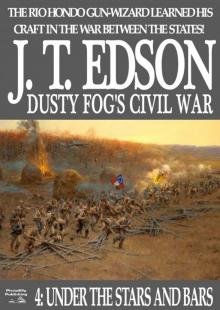 Under the Stars and Bars (A Dusty Fog Civil War Western Book 4)
Under the Stars and Bars (A Dusty Fog Civil War Western Book 4) The Floating Outfit 9
The Floating Outfit 9 Under the Stars and Bars
Under the Stars and Bars .44 Caliber Man
.44 Caliber Man The Floating Outfit 17
The Floating Outfit 17 Ole Devil at San Jacinto (Old Devil Hardin Western Book 4)
Ole Devil at San Jacinto (Old Devil Hardin Western Book 4) The Bloody Border
The Bloody Border A Horse Called Mogollon (Floating Outfit Book 3)
A Horse Called Mogollon (Floating Outfit Book 3) Waco 3
Waco 3 The Texan
The Texan The Floating Outfit 35
The Floating Outfit 35 Mississippi Raider
Mississippi Raider The Big Gun (Dusty Fog's Civil War Book 3)
The Big Gun (Dusty Fog's Civil War Book 3) Goodnight's Dream (A Floating Outfit Western Book 4)
Goodnight's Dream (A Floating Outfit Western Book 4) Waco 4
Waco 4 From Hide and Horn (A Floating Outfit Book Number 5)
From Hide and Horn (A Floating Outfit Book Number 5) The Floating Outfit 18
The Floating Outfit 18 Slaughter's Way (A J.T. Edson Western)
Slaughter's Way (A J.T. Edson Western) Dusty Fog's Civil War 7
Dusty Fog's Civil War 7 Two Miles to the Border (A J.T. Edson Western)
Two Miles to the Border (A J.T. Edson Western)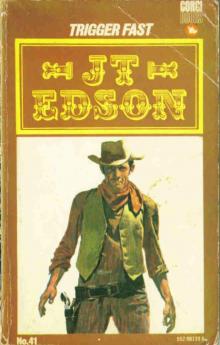 Trigger Fast
Trigger Fast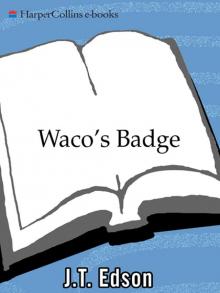 Waco's Badge
Waco's Badge A Matter of Honor (Dusty Fog Civil War Book 6)
A Matter of Honor (Dusty Fog Civil War Book 6) The Half Breed
The Half Breed Bunduki (Bunduki Series Book One)
Bunduki (Bunduki Series Book One) Kill Dusty Fog
Kill Dusty Fog Get Urrea! (An Ole Devil Hardin Western Book 5)
Get Urrea! (An Ole Devil Hardin Western Book 5) Dusty Fog's Civil War 9
Dusty Fog's Civil War 9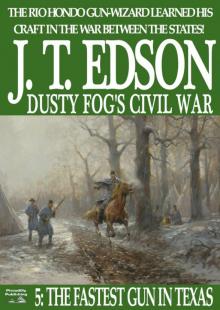 The Fastest Gun in Texas (A Dusty Fog Civil War Book 5)
The Fastest Gun in Texas (A Dusty Fog Civil War Book 5) Sagebrush Sleuth (A Waco Western #2)
Sagebrush Sleuth (A Waco Western #2) Quiet Town
Quiet Town Is-A-Man (A J.T. Edson Standalone Western)
Is-A-Man (A J.T. Edson Standalone Western) Rockabye County 5
Rockabye County 5 The Floating Outfit 14
The Floating Outfit 14 Cure the Texas Fever (A Waxahachie Smith Western--Book 3)
Cure the Texas Fever (A Waxahachie Smith Western--Book 3) The Floating Outfit 13
The Floating Outfit 13 The Road to Ratchet Creek
The Road to Ratchet Creek